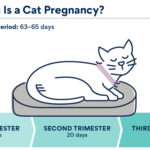Hyperthyroidism is a prevalent endocrine disorder in cats, particularly affecting those in their middle to senior years. Also known as thyrotoxicosis, this condition arises from an overproduction of thyroid hormones, specifically T3 and T4, by an enlarged thyroid gland located in the cat’s neck. In the majority of cases, this enlargement is due to a non-cancerous tumor called an adenoma. Less frequently, hyperthyroidism can be attributed to malignant tumors, known as thyroid adenocarcinomas. While the exact cause of feline hyperthyroidism remains elusive, potential contributing factors include dietary imbalances and exposure to environmental chemicals that disrupt thyroid function.
Thyroid hormones play a crucial role in regulating various bodily functions, influencing nearly every organ system. Consequently, hyperthyroidism can lead to a range of secondary health issues in affected cats, making timely diagnosis and management essential.
Recognizing the Clinical Signs of Hyperthyroidism in Cats
Cats suffering from hyperthyroidism often exhibit a spectrum of clinical signs that may initially be subtle but become progressively more pronounced as the disease advances. The most commonly observed symptoms include unexplained weight loss despite an increased appetite, coupled with increased thirst and urination. Furthermore, hyperthyroidism in cats can manifest as vomiting, diarrhea, and noticeable hyperactivity or restlessness. Changes in coat condition are also typical, with the fur often appearing unkempt, matted, or greasy.
Alt text: A senior cat with a dull, greasy coat, illustrating a visible sign of feline hyperthyroidism.
Diagnosing Hyperthyroidism in Your Cat
If a veterinarian suspects hyperthyroidism, a thorough physical examination will be conducted. This typically involves palpating the cat’s neck to assess for an enlarged thyroid gland. The veterinarian may also check the cat’s heart rate and blood pressure, as these can be affected by thyroid hormone levels. To confirm a diagnosis, blood tests are essential. A blood chemistry panel and thyroid hormone level analysis are usually ordered. The majority of cats with hyperthyroidism will show elevated levels of T4, the primary thyroid hormone, in their bloodstream. However, in some cases, T4 levels might fall within the normal range despite the presence of hyperthyroidism. If suspicion remains high despite normal T4 levels, further diagnostic tests may be recommended. Given the potential for hyperthyroidism to impact other organs, particularly the heart and kidneys, a comprehensive health evaluation, including a blood chemistry panel and urinalysis, is crucial to gain a complete picture of the cat’s overall health status.
Alt text: Close-up of a vet gently palpating a cat’s throat area, examining for an enlarged thyroid gland as part of a hyperthyroidism diagnosis.
Treatment Options for Feline Hyperthyroidism
There are four primary treatment approaches available for managing hyperthyroidism in cats: medication, radioactive iodine therapy, surgery, and dietary therapy. Each option presents its own set of advantages and disadvantages. The most suitable treatment plan is determined by various factors, including the cat’s overall health, the owner’s ability to administer medication consistently, and financial considerations.
Medication
Anti-thyroid medications work by inhibiting the production and release of thyroid hormones from the thyroid gland. While these drugs effectively manage hyperthyroidism, they do not offer a permanent cure. Medication can be used for both short-term stabilization and long-term control of the condition. The benefits of medication include its accessibility and relatively lower cost compared to other treatments. However, some cats may experience side effects such as vomiting, loss of appetite (anorexia), fever, anemia, and lethargy. Long-term management necessitates daily medication, typically administered orally twice a day, which can be challenging for some cat owners. Transdermal gel formulations of anti-thyroid medications are also available, offering an alternative application method with acceptable effectiveness in many cases. Regardless of the chosen medication, regular blood tests are vital to monitor treatment efficacy, kidney function, and to detect potential side effects.
Radioactive Iodine Therapy
Often considered the gold standard treatment, radioactive iodine therapy offers a high success rate for cats with hyperthyroidism. This treatment involves a single injection of radioactive iodine, which is rapidly absorbed into the bloodstream. The thyroid gland preferentially absorbs iodine to produce T3 and T4. The radioactive iodine then selectively destroys the overactive thyroid tissue without harming surrounding tissues, including the parathyroid glands. Most cats achieve normal thyroid hormone levels within a few weeks of treatment. Radioactive iodine therapy is advantageous because it frequently cures hyperthyroidism, has minimal serious side effects, and does not require general anesthesia. However, it necessitates specialized facilities licensed to handle radioisotopes, and treated cats require hospitalization for several days (typically three to five) until their radiation levels are within safe limits. During this period, strict protocols are in place to minimize radiation exposure to humans, often restricting visitors. Radioactive iodine therapy boasts a cure rate of approximately 95% within three months. In the rare instances where initial treatment is unsuccessful, it can be repeated. Hypothyroidism, a condition of reduced thyroid hormone levels, can occur in rare cases post-treatment. If hypothyroidism becomes clinically significant, thyroid hormone supplementation may be necessary.
Surgical Thyroidectomy
Surgical removal of the thyroid glands, known as thyroidectomy, is a surgical option with a good success rate. Surgery offers the potential for a long-term or permanent cure, eliminating the need for ongoing medication in many cats. However, surgical thyroidectomy requires general anesthesia, which carries inherent risks, particularly for older cats or those with pre-existing conditions like heart or kidney disease. A significant risk associated with surgery is potential damage to the parathyroid glands, which are located close to the thyroid and are vital for calcium regulation. Given the effectiveness and less invasive nature of medication and radioactive iodine therapy, surgery is less commonly chosen as the primary treatment for feline hyperthyroidism.
Dietary Therapy
Dietary management involving iodine restriction presents a potential treatment option for some cats with hyperthyroidism. This approach may be particularly useful for cats unsuitable for other treatments due to underlying health conditions. However, dietary iodine restriction remains somewhat controversial due to concerns about the long-term effects of iodine restriction on overall health and the potential for it to exacerbate hyperthyroidism in some cases. Research into this treatment modality is ongoing. Thorough discussion with a veterinarian is essential when considering dietary iodine restriction for managing feline hyperthyroidism.
Secondary Problems Associated with Hyperthyroidism
Due to the thyroid gland’s widespread influence on the body, hyperthyroidism can trigger secondary health problems, most notably heart disease and high blood pressure (hypertension). Elevated thyroid hormones can lead to an increased heart rate and stronger heart muscle contractions, potentially causing thickening of the heart’s left ventricle over time. Untreated, these cardiac changes can compromise heart function and potentially lead to heart failure. Therefore, some cats with hyperthyroidism may require concurrent treatment for heart disease. However, effectively managing the underlying hyperthyroidism often leads to improvement or resolution of these cardiac issues. Hypertension is another potential complication, which can damage various organs, including the eyes, kidneys, heart, and brain. If hypertension is diagnosed alongside hyperthyroidism, blood pressure-lowering medications may be necessary. Similar to heart disease, hypertension often resolves once hyperthyroidism is successfully treated, potentially eliminating the need for long-term blood pressure management.
Prognosis for Cats with Hyperthyroidism
Generally, the prognosis for cats diagnosed with hyperthyroidism is favorable with appropriate treatment. However, the presence of complications involving other organs can influence the overall prognosis. Early diagnosis and consistent management are key to ensuring a good quality of life for cats with hyperthyroidism.
Updated January 2024


